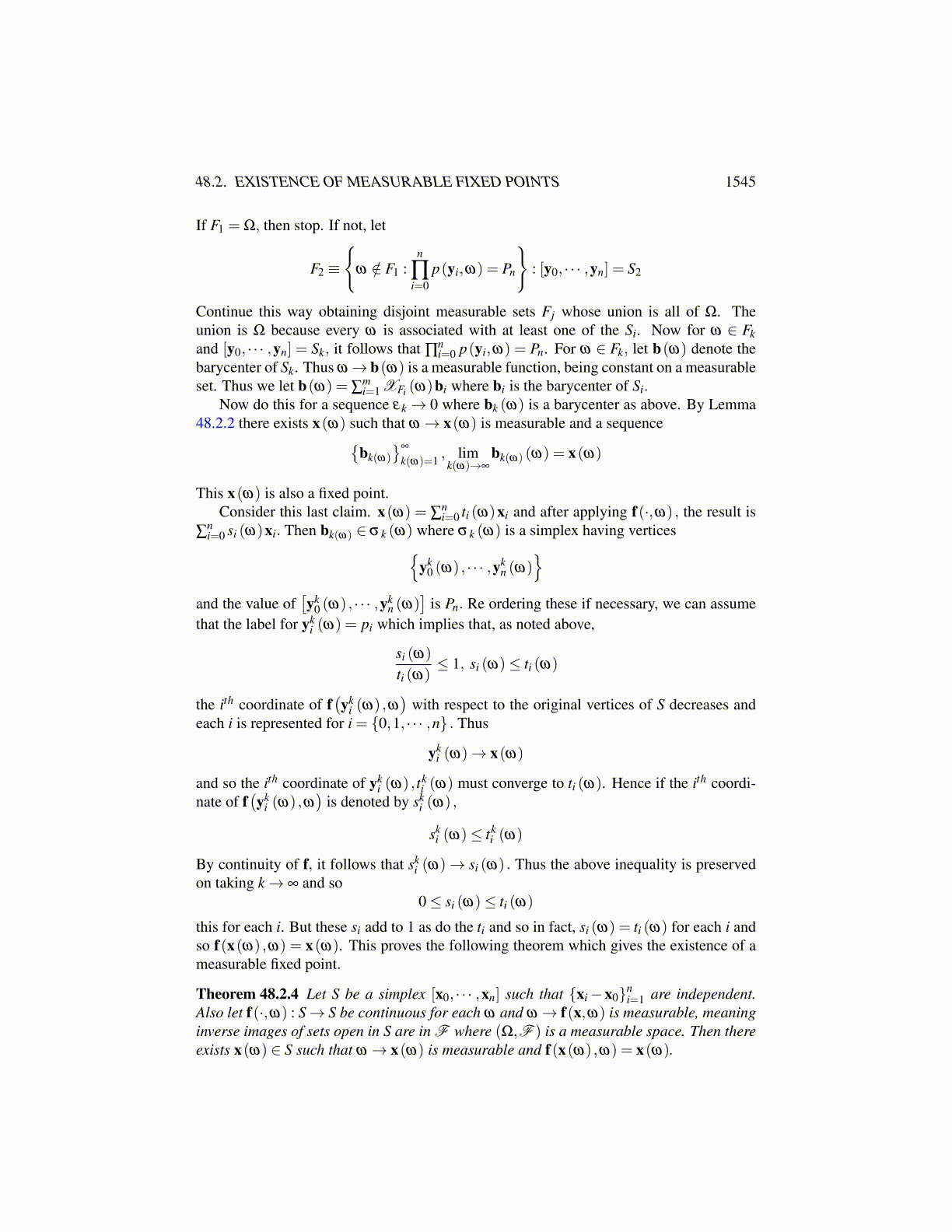
48.2. EXISTENCE OF MEASURABLE FIXED POINTS 1545
and then for H closed,Γ− (H) = ∩nΓ
−n (H)
and each set in the intersection is measurable, so this shows that ω→ Γ(ω) is also stronglymeasurable. Therefore, it has a measurable selection u(ω). It follows from the definitionof Γ(ω) that there exists a subsequence n(ω) such that u(ω) = limn(ω)→∞ un(ω) (ω).
Now we consider the case of fixed points for simplices.Suppose f(·,ω) : S→ S for S a simplex. Then from the Brouwer fixed point theorem,
there is a fixed point x(ω) provided f(·,ω) is continuous. Can it be arranged to haveω→ x(ω) also measurable? In fact, it can, and this is shown here. In other words, if P(ω)are the fixed points of f (·,ω) , there exists a measurable selection in P(ω).
S≡ [x0, · · · ,xn] is a simplex in Rn. Assume {xi−x0}ni=1 are linearly independent. Thus
a typical point of S is of the formn
∑i=0
tixi
where the ti are uniquely determined and the map x→ t is continuous from S to the compactset{
t ∈ Rn+1 : ∑ ti = 1, ti ≥ 0}
.To see this, suppose xk → x in S. Let xk ≡ ∑
ni=0 tk
i xi with x defined similarly with tki
replaced with ti, x≡∑ni=0 tixi. Then
xk−x0 =n
∑i=0
tki xi−
n
∑i=0
tki x0 =
n
∑i=1
tki (xi−x0)
Thus
xk−x0 =n
∑i=1
tki (xi−x0) , x−x0 =
n
∑i=1
ti (xi−x0)
Say tki fails to converge to ti for all i ≥ 1. Then there exists a subsequence, still denoted
with superscript k such that for each i = 1, · · · ,n, it follows that tki → si where si ≥ 0 and
some si ̸= ti. But then, taking a limit, it follows that
x−x0 =n
∑i=1
si (xi−x0) =n
∑i=1
ti (xi−x0)
which contradicts independence of the xi− x0. It follows that for all i ≥ 1, tki → ti. Since
they all sum to 1, this implies that also tk0 → t0. Thus the claim about continuity is verified.
Let f(·,ω) : S→ S be continuous such that ω → f(x,ω) is measurable. When doingf(·,ω) to a point ∑
ni=0 tixi, one obtains another point of S denoted as ∑
ni=0 si (ω)xi. The
coefficients si must be measurable functions. This is because
ω → f(x,ω) =n
∑i=0
si (ω)xi
and the left side is measurable so it follows the right is also. Now as noted above, the mapwhich takes a point of S to its coefficients is continuous and so each si is measurable as afunction of ω . Note that if x is replaced with x(ω) , with ω → x(ω) measurable, the same